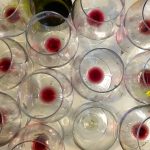Sustainability is not just a trend, at Pieve de’ Pitti.
I was an architect before becoming a winemaker, but moreover I was an architect specialized in sustainable architecture before becoming an organic winemaker.
My PhD thesis on “Sustainability in winery design” perfectly describes how I did my best to combine these two great passions and where the phylosophy and the taste of Pieve de’ Pitti wines come from.
There are several sustainable strategies that have been adopted by Pieve de’ Pitti, not in winegrowing or winemaking only.
This is a very simple list of what we do, every day, in the vineyards, in the cellar, inside and outside
Caterina
vignaiolo
ENERGY AND RESOURCE SAVINGS
No fossil fuels for heating and hot water but biomass only: wood, vines and olive trees pruning residues, olive stones or pellet are used as fuel
There is a monthly control over fuel consumption for tractor in order to minimize the hour/hectare working rate
Ground water is used for all of the uses and rainwater is collected in big tanks to be used for the cellar and the sanitary appliances
Waste collection and recycling strategies are adopted as in the office as in the farmhouse. Guest are asked to respect the rules and separate domestic waste.
Advices for energy and water saving are hung in the common area, in the B&B rooms, in the farmhouse apartments
ORGANIC PRODUCTION
The entire production (wine, olive oil) is certified organic
No chemical pesticide are used in vineyards and olive groves but also no herbicide nor chemical fertilizers. Manuring is based on animal or green manure only. Moreover, lees and pomaces are collected to produce compost that is then recycled as fertilizer in vineyards.
All activities are done by hand.
Wine: natural yeasts are preferred to starts all fermentation processes. Sometimes it happens that the first volume of must doesn’t ferment in the proper way, then commercial yeast is used to save the vintage production. No cleaning/clarifying agents are used. No extra tannins are added. All daily pumping over are done manually splashing must over the cap. Racking is also done by hand in small bins, to be spilled into the press. Sulphites are added when necessary but total sulphites content is, in general, still far below organic limits. Wines cointain around 30-50gr/lt .
CELLAR DESIGN and MANAGEMENT
The cellar climate is naturally regulated by the underground tuff tunnel that brings humidity and cold air during the summertime so that air conditioning is not needed.
Fermentation of red wines is in concrete tanks: during the day, the mass of concrete walls absorbs the heat produced by grapes during the fermentation due to its thermal capacity and releases it back to the cellar space during the night, when walls are licked by cold air arriving from the tunnel. That’s a passive strategy to control the fermentation temperature so chilled thanks are not needed.
Water for washing and cleaning wine thanks is stored and, when possible, reused to clean floors.
No energy is consumed to chill the white must before the fermentation: grapes are harvested very early in the morning and delivered to the cellar immediately. When necessary, dry ice is used instead.
The basement cellar has cross windows that favorite natural ventilation and faces north, so that the south face is totally underground and the main façade is never sunlit. Climate control in the indoor area of the cellar doesn’t require and energy consuming appliance.
PACKAGING
Starting from 2020, the lightest glass bottles have been selected, according to the different shapes, to bottles all of the wines. No more compromise for market or fashion matter. Light glass means less energy used to produce the bottle and, moreover, less fuel necessary to deliver wines to your home door.
Pieve de’ Pitti still uses natural corks for the traditional white and red wines but has recently introduced 100% biomass and 100% recyclable cork (by sugar can).
Starting from 2022, the new carton boxes don’t require the use of any adhesive tape and the boxes are stored and packed on wooden pallets covered with 100% recycled extendable film.
All the wine technical card have been made available for download on the website so to reduce the paper consumption for printing.
CIRCULARITY
Codes for the correct disposal of packaging are clearly indicated on all of our wine labels.
Remember to always check the specific provisions of your municipality for the correct management and waste collection

 CAMPAIGN FINANCED ACCORDING TO (EU) REGULATION N. 1308/13
CAMPAIGN FINANCED ACCORDING TO (EU) REGULATION N. 1308/13


